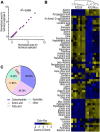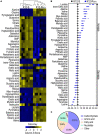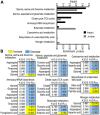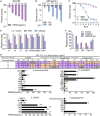Glutamine potentiates gentamicin to kill lab-evolved gentamicin-resistant and clinically isolated multidrug-resistant Escherichia coli
- PMID: 36532472
- PMCID: PMC9755591
- DOI: 10.3389/fmicb.2022.1071278
Glutamine potentiates gentamicin to kill lab-evolved gentamicin-resistant and clinically isolated multidrug-resistant Escherichia coli
Abstract
Introduction: Gentamicin is a conventional antibiotic in clinic. However, with the wide use of antibiotics, gentamicin-resistant Escherichia coli (E. coli) is an ever-increasing problem that causes infection in both humans and animals. Thus, it is especially important to restore gentamicin-mediated killing efficacy.
Method: E. coli K12 BW25113 cells were passaged in medium with and without gentamicin and obtain gentamicin-resistant (K12-R GEN ) and control (K12-S) strains, respectively. Then, the metabonomics of the two strains were analyzed by GC-MS approach.
Results: K12-R GEN metabolome was characterized as more decreased metabolites than increased metabolites. Meantime, in the most enriched metabolic pathways, almost all of the metabolites were depressed. Alanine, aspartate and glutamate metabolism and glutamine within the metabolic pathway were identified as the most key metabolic pathways and the most crucial biomarkers, respectively. Exogenous glutamine potentiated gentamicin-mediated killing efficacy in glutamine and gentamicin dose-and time-dependent manners in K12-R GEN . Further experiments showed that glutamine-enabled killing by gentamicin was effective to clinically isolated multidrug-resistant E. coli.
Discussion: These results suggest that glutamine provides an ideal metabolic environment to restore gentamicin-mediated killing, which not only indicates that glutamine is a broad-spectrum antibiotic synergist, but also expands the range of metabolites that contribute to the bactericidal efficiency of aminoglycosides.
Keywords: Escherichia coli; aminoglycoside; antibiotic resistance; glutamine; multidrug resistance; reprogramming metabolomics.
Copyright © 2022 Chen, Ma, Peng and Li.
Conflict of interest statement
The authors declare that the research was conducted in the absence of any commercial or financial relationships that could be construed as a potential conflict of interest.
Figures






Similar articles
-
Glutamine promotes antibiotic uptake to kill multidrug-resistant uropathogenic bacteria.Sci Transl Med. 2021 Dec 22;13(625):eabj0716. doi: 10.1126/scitranslmed.abj0716. Epub 2021 Dec 22. Sci Transl Med. 2021. PMID: 34936385
-
Fructose-enabled killing of antibiotic-resistant Salmonella enteritidis by gentamicin: Insight from reprogramming metabolomics.Int J Antimicrob Agents. 2023 Sep;62(3):106907. doi: 10.1016/j.ijantimicag.2023.106907. Epub 2023 Jun 28. Int J Antimicrob Agents. 2023. PMID: 37385564
-
Upregulated Palmitoleate and Oleate Production in Escherichia coli Promotes Gentamicin Resistance.Molecules. 2024 May 25;29(11):2504. doi: 10.3390/molecules29112504. Molecules. 2024. PMID: 38893378 Free PMC article.
-
Sisomicin, netilmicin and dibekacin. A review of their antibacterial activity and therapeutic use.Drugs. 1984 Jun;27(6):548-78. doi: 10.2165/00003495-198427060-00003. Drugs. 1984. PMID: 6376062 Review.
-
Recent advances in the biosynthesis and production optimization of gentamicin: A critical review.Synth Syst Biotechnol. 2024 Nov 14;10(1):247-261. doi: 10.1016/j.synbio.2024.11.003. eCollection 2025. Synth Syst Biotechnol. 2024. PMID: 39640289 Free PMC article. Review.
Cited by
-
Aminoglycoside uptake, stress, and potentiation in Gram-negative bacteria: new therapies with old molecules.Microbiol Mol Biol Rev. 2023 Dec 20;87(4):e0003622. doi: 10.1128/mmbr.00036-22. Epub 2023 Dec 4. Microbiol Mol Biol Rev. 2023. PMID: 38047635 Free PMC article. Review.
-
Resistance Response and Regulatory Mechanisms of Ciprofloxacin-Induced Resistant Salmonella Typhimurium Based on Comprehensive Transcriptomic and Metabolomic Analysis.Antibiotics (Basel). 2025 Jul 29;14(8):767. doi: 10.3390/antibiotics14080767. Antibiotics (Basel). 2025. PMID: 40867962 Free PMC article.
-
pts promoter influences antibiotic resistance via proton motive force and ROS in Escherichia coli.Front Microbiol. 2023 Nov 6;14:1276954. doi: 10.3389/fmicb.2023.1276954. eCollection 2023. Front Microbiol. 2023. PMID: 38029124 Free PMC article.
-
A glucose-mediated antibiotic resistance metabolic flux from glycolysis, the pyruvate cycle, and glutamate metabolism to purine metabolism.Front Microbiol. 2023 Oct 17;14:1267729. doi: 10.3389/fmicb.2023.1267729. eCollection 2023. Front Microbiol. 2023. PMID: 37915850 Free PMC article.
-
Valine potentiates cefoperazone-sulbactam to kill methicillin-resistant Staphylococcus aureus.mSystems. 2025 Jan 21;10(1):e0124424. doi: 10.1128/msystems.01244-24. Epub 2024 Dec 18. mSystems. 2025. PMID: 39692510 Free PMC article.
References
-
- CLSI (2012). Methods for Dilution Antimicrobial Susceptibility Tests for Bacteria that Grow Aerobically; Approved Standard. CLSI document M07-A9, 9 Edn. Wayne, PA: Clinical and Laboratory Standards Institute.
LinkOut - more resources
Full Text Sources
Miscellaneous

